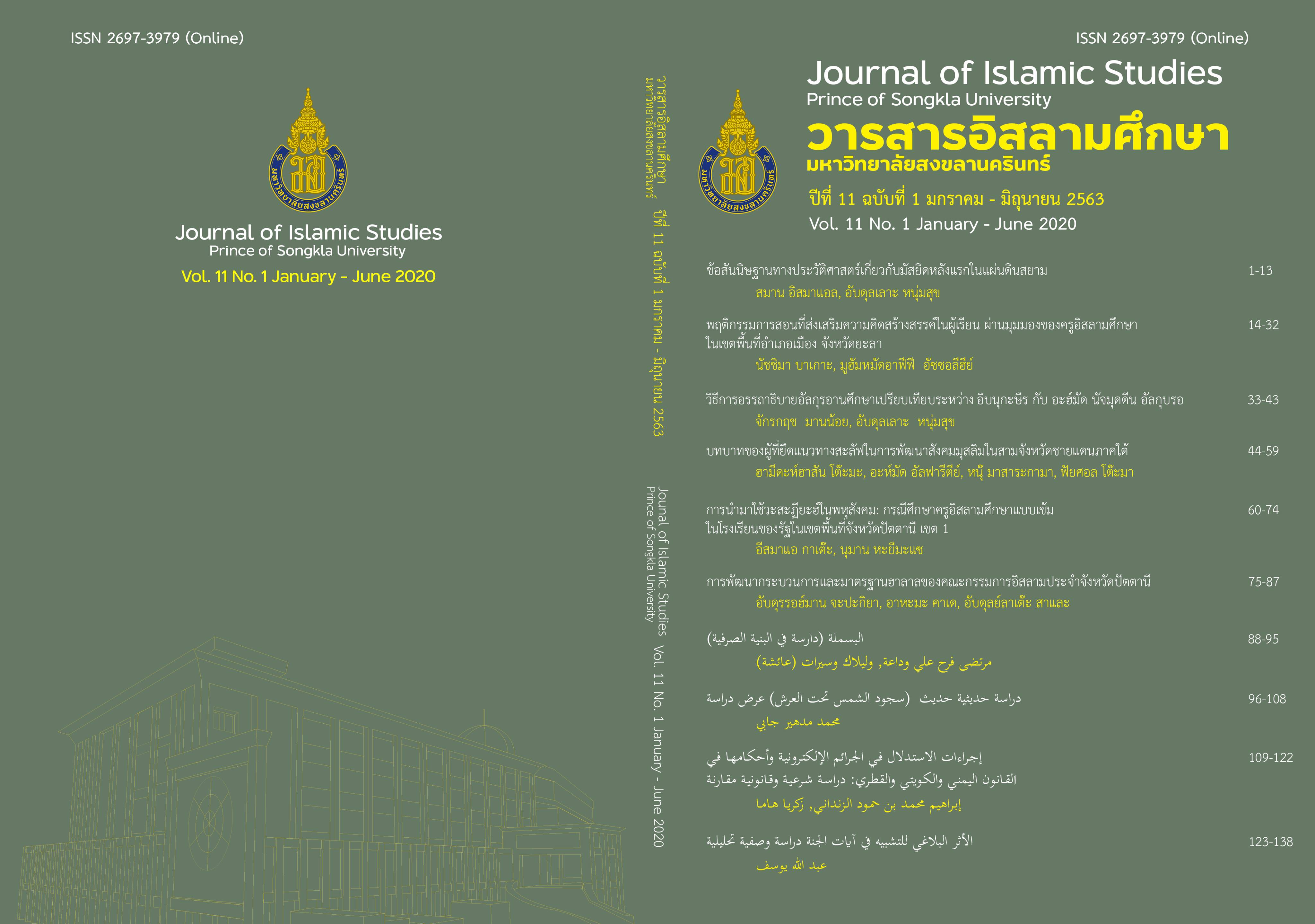ข้อสันนิษฐานทางประวัติศาสตร์เกี่ยวกับมัสยิดหลังแรกในแผ่นดินสยาม
คำสำคัญ:
สยาม, มัสยิด,, ปสาน, พระอจนะ, วัดศรีชุมบทคัดย่อ
การวิจัยครั้งนี้มีวัตถุประสงค์เพื่อศึกษาและอภิปรายบทบาทของการก่อตั้งชุมชนมุสลิมในสมัยสุโขทัยจากหลักฐานที่ปรากฏในศิลาจารึกหลักที่ 1 ของพ่อขุนรามคำแหง ซึ่งปัจจุบันถูกเก็บไว้ในพิพิธภัณฑสถานแห่งชาติพระนครด้านเหนือชั้นบนในห้องที่ใช้แสดงศิลปะสมัยสุโขทัยเพื่อเก็บไว้เป็นประโยชน์ในการศึกษาด้านประวัติศาสตร์และโบราณคดี การศึกษาวิจัยครั้งนี้เป็นการวิจัยเชิงคุณภาพโดยการศึกษาภาคเอกสารจากศิลาจารึกหลักที่ 1 ของพ่อขุนรามคำแหงด้านที่ 3 บรรทัดที่ 2 จารึกไว้ว่า “เบื้องตีนนอนเมืองสุโขทัยนี้มีตลาดปสาน มีพระอจนะ มีปราสาท” ศึกษาเปรียบเทียบกับข้อความในศิลาจารึกหลักเดียวกันด้านที่ 2 ที่จารึกไว้ว่า “กลางเมืองสุโขทัยนี้ มีพิหาร มีพระพุทธรูปทอง มีพระอัฎฐารศ” ศึกษาความหมายของพระอจนะที่จารึกไว้ต่อจากตลาดปสานในบรรทัดเดียวกันของด้านที่ 3 บรรดทัดที่ 2 แล้วนำมาเปรียบเทียบกับแผนที่โบราณและจดหมายเหตุต่าง ๆ ทั้งจากภายในประเทศและจากต่างประเทศเพื่อตามหาชุมชนมุสลิมที่ตั้งอยู่ใกล้กับตลาดปสานว่าเป็นตำบลฤๅษีชุมหรือไม่ ? ทำไมเรียกว่าฤๅษีชุม ? คำว่าฤๅษีชุมนั้นมีข้อบ่งชี้ถึงมุสลิมหรือไม่ ? ทำไมจึงเปลี่ยนชื่อจากวัดฤๅษีชุมเป็นวัดศรีชุม ? และวิเคราะห์เกี่ยวกับการดำรงอยู่และการหายไปของมุสลิมย่านตลาดปสานในตำบลฤๅษีชุม
เอกสารอ้างอิง
เกริกฤทธิ์ เชื้อมงคล. (2558). สุโขทัย ตำนานการสร้างเมือง. กรุงเทพฯ: สยามความรู้.
กรมพระปรมานุชิตชิโนรส. สมเด็ด. (2485). พระราชพงศาวดารกรุงศรีอยุธยา ฉบับสมเด็ดกรมพระปรมานุชิตชิโนรส เล่ม 1 ตั้งแต่สร้างกรุงศรีอยุธยาถึง สิ้นรัชกาลสมเด็ดพระนเรศวรมหาราช. พิมพ์พระราชทานในงานเมรุ นายพลเอก อุ่ม พิชเยนทรโยธิน ผู้สำเร็จราชการแทนพระองค์ เมื่อวันที่ 16 ธันวาคม พ.ศ. 2485 ณ เมรวัดเทพศิรินทราวาส.
เฉลิม ยงบุญเกิด. (2557). บันทึกว่าด้วยขนบธรรมเนียมประเพณีของเจินละ. กรุงเทพฯ: มติชน.
ประยูรศักดิ์ ชลายนเดชะ. (2539). มุสลิมในประเทศไทย. กรุงเทพฯ: โครงการหอสมุดกลางอิสลามสายสกุลสุลต่านสุลัยมาน.
มงกุฏเกล้าเจ้าอยู่หัว, พระบาทสมเด็จพระ. (2526). เที่ยวเมืองพระร่วง. กรุงเทพฯ: พระจันทร์.
วริศรา ตั้งค้าวานิช. (2557) ประวัติศาสตร์ “สุโขทัย” ที่เพิ่งสร้าง. กรุงเทพฯ: มติชน.
ศุภการ สิริไพศาล และ พิภู บุษบก. (2561). รายงานการวิจัยการแปลและศึกษาเอกสารจีนโบราณเกี่ยวกับไทยในบริบทของเส้นทางสายไหม. ทุนอุดหนุนการวิจัยจากศูนย์มานุษยวิทยาสิรินธร (องค์การมหาชน).
สุดใจ ตัณฑากาศ(พระเจนจีนอักษร). (2507). จดหมายเหตุเรื่องพระราชไม่ตรีระหว่างกรุงสยามกับกรุงจีน และ นิราศพระยามหานุภาพไปเมืองจีน. เสียมหลอก๊ก. น. 5. กรุงเทพฯ: นายนิสสัย เวชชาชีวะ พิมพ์เป็นอนุสรณ์ในงานณาปนกิจศพ นายโฆษิต เวชาชาชีวะ ณ สุสานหลวง วัดเทพศริรินทราวาส 27 เมษายน 2507.
สุเนตร ชุตินธรานนท์ และคณะ. (2557). ชาตินิยมในแบบเรียน. กรุงเทพฯ: มติชน.
หอจดหมายเหตุ. (2560). จารึกวัดศรีชุม มรดกความทรงจำจากยุคสุโขทัย. เรื่อเก่าเล่าอดีต. หอจดหมายเหตุ สัครสังฆมณฑลกรุงเทพฯ. สืบค้นเมื่อ 14 มกราคม 2562 จากhttp://catholichaab.com/main/index.php/research-and-study/2016-12-14-03-46-25/1572-2017-06-29-02-37-45
อุทยานประวัติศาสตร์สุโขทัย. (2563). “ภาพถ่ายเก่า” บูรณะวัดศรีชุม. อุทยานประวัติศาสตร์สุโขทัย. สืบค้นเมื่อ 20 มกราคม 2562 จาก https://www.silpa-mag.com/old-photos-tell-the-historical-story/article_17681
George Lane. (2011). SAYYED AJALL. Encyclopaedia Iranica. Retrieved April 8, 2020, from http://www.iranicaonline.org/articles/sayyed-ajall
Lofland, J. (1984). Analyzing Social Settings. Blemont, Calif, Wadworth.
Marco Polo. Newly translated and edited, with note by Colonel Henry Yule, C.B., (1871). The Book of Ser Marco Polo the Venetian. Vol II. London: Jhon Murry, Albermal Street.
Prarang Museum. (2019 January 10). India Orientalis, Hondius - Mercator Atlas, 1606. The story of the Indian civilization through the evolution of its cities & towns, along its rivers. Retrieved April 7, 2020, at 15.56 pm., from http://indiavisual.com/categories1.php?id=54
ดาวน์โหลด
เผยแพร่แล้ว
รูปแบบการอ้างอิง
ฉบับ
ประเภทบทความ
สัญญาอนุญาต
บทความทุกเรื่อง ที่ได้รับการตีพิมพ์ในวารสารอิสลามศึกษาเป็นแนวคิดของผู้เขียน มิใช่เป็นความคิดเห็นคณะผู้จัดทำและมิใช่ความรับผิดชอบของคณะวิทยาการอิสลาม กองบรรณาธิการไม่สงวนสิทธิ์การคัดลอก แต่ให้มีการอ้างอิงแสดงที่มา






